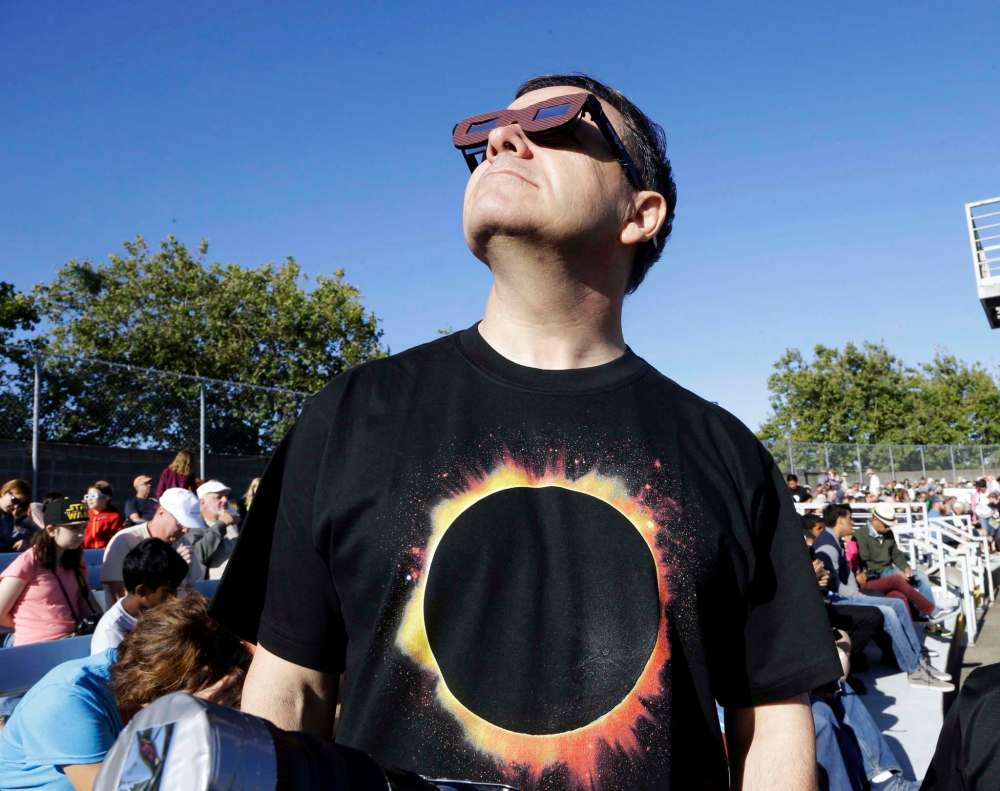Solar eclipse turned our focus to bigger things
Advertisement
Read this article for free:
or
Already have an account? Log in here »
To continue reading, please subscribe:
Monthly Digital Subscription
$0 for the first 4 weeks*
- Enjoy unlimited reading on winnipegfreepress.com
- Read the E-Edition, our digital replica newspaper
- Access News Break, our award-winning app
- Play interactive puzzles
*No charge for 4 weeks then price increases to the regular rate of $19.00 plus GST every four weeks. Offer available to new and qualified returning subscribers only. Cancel any time.
Monthly Digital Subscription
$4.75/week*
- Enjoy unlimited reading on winnipegfreepress.com
- Read the E-Edition, our digital replica newspaper
- Access News Break, our award-winning app
- Play interactive puzzles
*Billed as $19 plus GST every four weeks. Cancel any time.
To continue reading, please subscribe:
Add Free Press access to your Brandon Sun subscription for only an additional
$1 for the first 4 weeks*
*Your next subscription payment will increase by $1.00 and you will be charged $16.99 plus GST for four weeks. After four weeks, your payment will increase to $23.99 plus GST every four weeks.
Read unlimited articles for free today:
or
Already have an account? Log in here »
Hey there, time traveller!
This article was published 22/08/2017 (3045 days ago), so information in it may no longer be current.
The greatest danger in Monday’s solar eclipse was that we would look at it. The human eye, a wonderful organ, is not made to see such intense light. We are made to see the sun’s reflected light. The sun itself, unmediated, will blind us.
We know that and ordinarily we don’t look at the sun except at sunrise or sunset when its slanting rays, clouded by Earth’s atmosphere, are merely dazzling and not literally blinding. However, the solar eclipse — a rare and wondrous moment — stirred something within millions of people and drew their gaze where it cannot go: to look at the midday sun as it disappeared behind the moon.
Clouds over this region spared Manitobans from any danger of seeing the event directly and blinding themselves. We knew it was happening, however — and we knew that eclipse watchers had gathered from far and wide at viewing spots in the narrow band from Oregon to South Carolina where the sun would, for two or two and a half minutes, be totally obscured by the intervening moon. Those lucky enough to get the right eyewear and the right sky conditions could watch the whole thing.

Even for those who could not watch it directly, the celestial event claimed attention. Our minds were raised above earthly things and fixed for a moment in a sphere we hardly know. The usual squabbles sank into insignificance. There was nothing for the government to do about it or for the opposition to protest. At last it did not matter whether the Democrats or the Republicans liked the event or not. Was Kim Jong Un offended? Were the central bankers alarmed? Who cares? This was an event far beyond the usual human scope and scale.
Ancient mathematicians figured out how to predict solar eclipses, but the phenomenon kept its hold on the human imagination. Disappearances of the sun at midday seemed like auguries of something amazing — the rise of kings and the fall of empires. Today, astronomers can tell you, to the centimetre and to the second, when and where the eclipse will be seen and how long it will last. The mechanical explanation of a solar eclipse seems simple enough when you draw it on a blackboard, but the explanation misses something essential.
Monday’s eclipse had the power to draw us out of ourselves and to create a breathtakingly large context for our lives, our struggles and our daily anxieties. We kind of know all the time that we live with the fine balance between powerful forces that could fling our planet off into the cold outer reaches of the solar system or plunge it to destruction in the middle of the sun, but we give it no thought.
On Monday, however, the moon — held in its orbit by those same forces — brushed its shadow against our planet and the sun’s heat was for a moment blocked. The inner workings of the solar system were suddenly dramatized before our eyes. We were shown how small our strivings are compared to the immensity and power of the universe that gives us life.
That knowledge should not blind us to the power and value of human action, but we should welcome the chance to project our minds far from here and see ourselves and our planet in this wider, celestial context.




